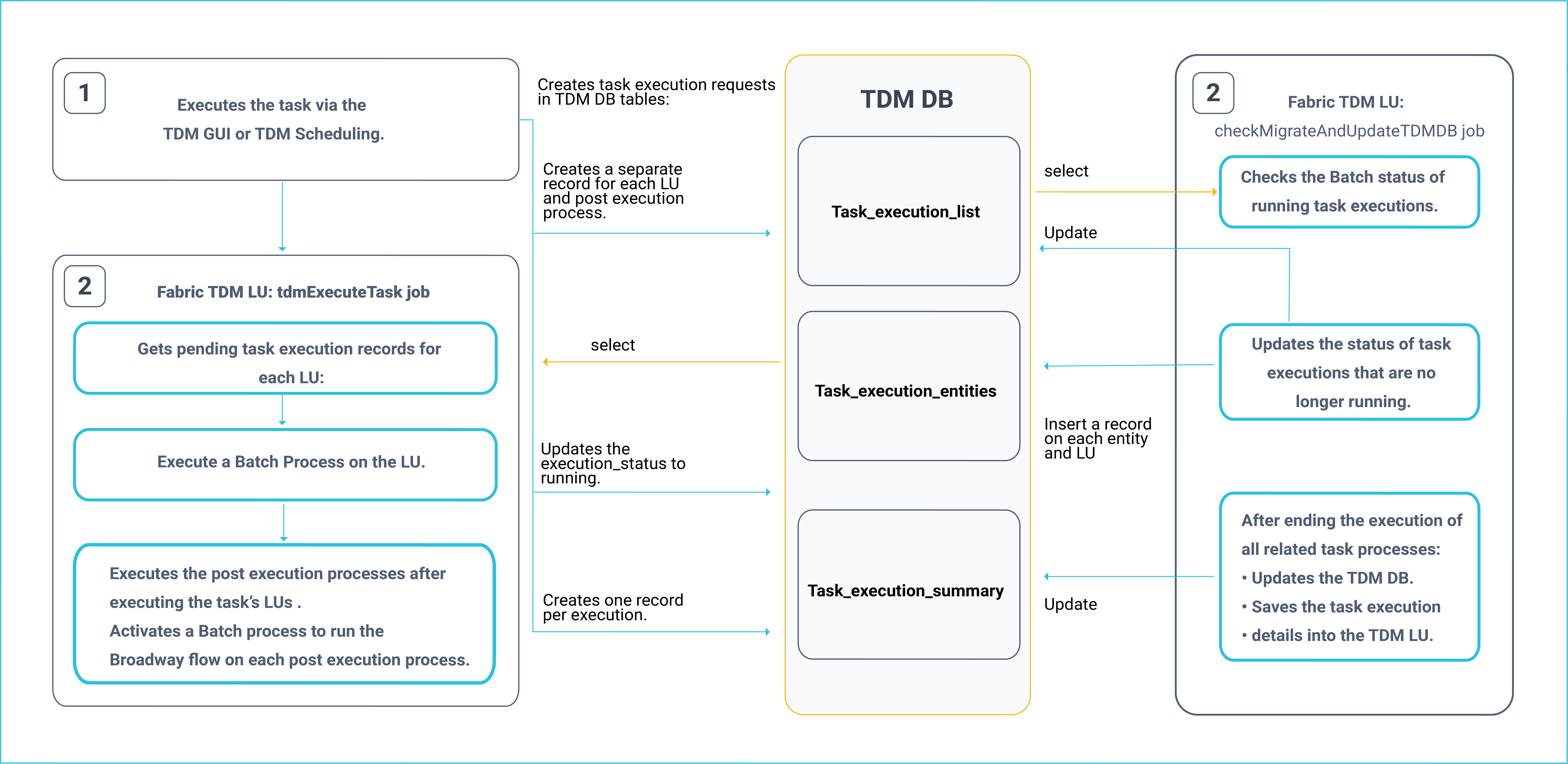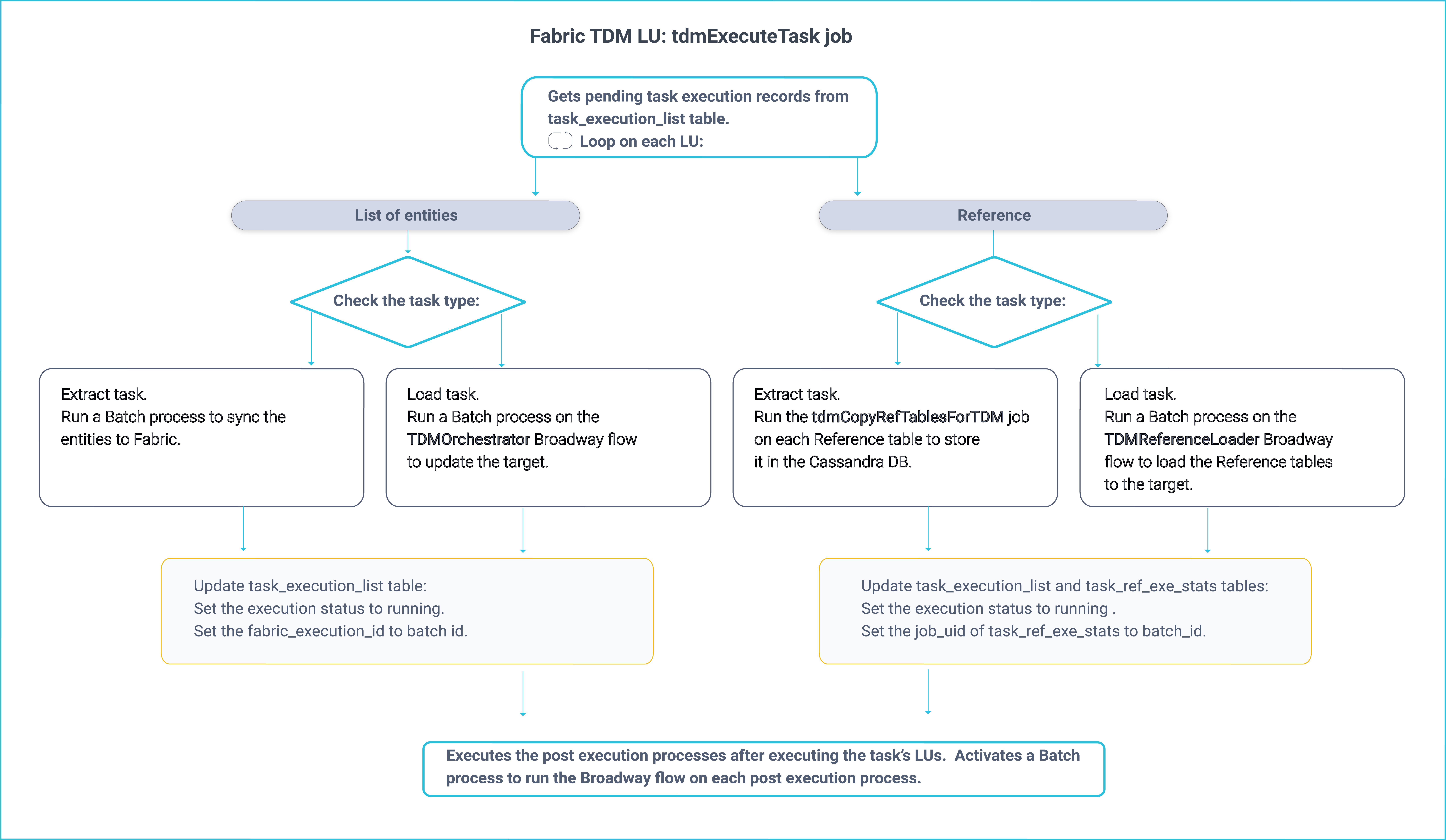Task Execution Processes
The Task Execution process has the following steps:
- Creating a task execution request.
- Initiating a Batch process on the task's LU and implementing post execution processes in asynchronous mode.
- Updating the status of the completed processes.
A Task Execution process can be initiated either from the TDM GUI or via a TDM Scheduling process.
This article discusses initiating a Batch process on a task's LUs and updating the status of the completed process.
A task can include Entities, Reference tables and post-execution processes. For example, sending a mail to a user after a task has been executed.
The following diagram displays the task execution process:

Main TDM Task Execution Process: tdmExecuteTask Job
This job runs every 10 seconds and scans the task_execution_list in the TDM DB table to get pending task execution requests.
Each task execution gets a unique task_execution_id identifier. A task execution may include several LUs and post execution processes, each with a separate record in the task_execution_list. All records related to a given task execution have the same task_execution_id.
The task execution order of the related task's components is as follows:
LUs, run the LUs from parent to child. Process all related entities on each LU before moving to its child LU. Click for more information about the execution order of the hierarchical LUs.
Post Execution Processes, run the post execution processes after the execution of the LUs ends. Post execution processes are executed according to their execution order as defined in the task's BE.
The following diagram describes the main TDM Task Execution process:

The execution is implemented in an asynchronous mode, the tdmExecuteTask job starts the execution on each LU or post execution process and a separate checkMigrateAndUpdateTDMDB job checks and updates the execution status of each process.
Both jobs must be executed in parallel.
Example:
- Execute a task with Customer and Billing LUs and with a post execution process that sends a mail when the task execution ends. The Customer is the parent LU of Billing.
- Three records are created in the task_execution_list on this task. All have the same task_execution_id.
- The tdmExecuteTask job executes the Batch process on the Customer LU.
- The checkMigrateAndUpdateTDMDB job updates the status of Customer LU when the execution is completed.
- The tdmExecuteTask job starts executing Billing LU since Customer, its parent LU, is marked as completed.
- The checkMigrateAndUpdateTDMDB job updates the status of Billing LU when the execution is completed.
- The tdmExecuteTask job can start executing the post execution process after the execution of all the task's LUs.
checkMigrateAndUpdateTDMDB Job
This job runs every 10 seconds and checks the execution status of the running process. It selects records from the task_execution_list in the TDM DB table where the execution_status is running.
The execution status is checked as follows:
- Reference tables, check the execution status or all related Reference tables in task_exe_ref_stats in the TDM DB table.
- Processed entities of each LU, check the batch status based on the batch_id populated in task_execution_list.fabric_execution_id column by the tdmExecuteTask job.
When the process is completed, the following TDM DB tables are updated:
- task_execution_list, update the execution_status and additional data.
- task_execution_entities, populate each entity or Reference table and its status. Set the id_type to ENTITY or REFERENCE according the entity or Reference table data type.
- task_exe_error_detailed, populate the execution errors in Extract tasks. Note that the execution errors of Load tasks are reported to this table by the PopulateTableErrors Actor.
Handling Completed Task Executions
A task execution is completed when it does not have pending or running executions. The checkMigrateAndUpdateTDMDB job handles completed task executions as follows:
- Updates the execution summary in the TDM DB tables.
- Synchronizes the task execution details to Fabric.
Updating Execution Summary TDM Tables
Updates the following TDM DB tables:
Sync the Task Execution ID to TDM LU
The TDM LU holds the execution details of each task execution. The TDM's instance ID is the task_execution_id generated by the TDM GUI for each task execution.
A completed task execution is synchronized into the TDM LU. The execution information and the TDM execution reports are extracted from the TDM LUI data.
Task Execution Processes
The Task Execution process has the following steps:
- Creating a task execution request.
- Initiating a Batch process on the task's LU and implementing post execution processes in asynchronous mode.
- Updating the status of the completed processes.
A Task Execution process can be initiated either from the TDM GUI or via a TDM Scheduling process.
This article discusses initiating a Batch process on a task's LUs and updating the status of the completed process.
A task can include Entities, Reference tables and post-execution processes. For example, sending a mail to a user after a task has been executed.
The following diagram displays the task execution process:

Main TDM Task Execution Process: tdmExecuteTask Job
This job runs every 10 seconds and scans the task_execution_list in the TDM DB table to get pending task execution requests.
Each task execution gets a unique task_execution_id identifier. A task execution may include several LUs and post execution processes, each with a separate record in the task_execution_list. All records related to a given task execution have the same task_execution_id.
The task execution order of the related task's components is as follows:
LUs, run the LUs from parent to child. Process all related entities on each LU before moving to its child LU. Click for more information about the execution order of the hierarchical LUs.
Post Execution Processes, run the post execution processes after the execution of the LUs ends. Post execution processes are executed according to their execution order as defined in the task's BE.
The following diagram describes the main TDM Task Execution process:

The execution is implemented in an asynchronous mode, the tdmExecuteTask job starts the execution on each LU or post execution process and a separate checkMigrateAndUpdateTDMDB job checks and updates the execution status of each process.
Both jobs must be executed in parallel.
Example:
- Execute a task with Customer and Billing LUs and with a post execution process that sends a mail when the task execution ends. The Customer is the parent LU of Billing.
- Three records are created in the task_execution_list on this task. All have the same task_execution_id.
- The tdmExecuteTask job executes the Batch process on the Customer LU.
- The checkMigrateAndUpdateTDMDB job updates the status of Customer LU when the execution is completed.
- The tdmExecuteTask job starts executing Billing LU since Customer, its parent LU, is marked as completed.
- The checkMigrateAndUpdateTDMDB job updates the status of Billing LU when the execution is completed.
- The tdmExecuteTask job can start executing the post execution process after the execution of all the task's LUs.
checkMigrateAndUpdateTDMDB Job
This job runs every 10 seconds and checks the execution status of the running process. It selects records from the task_execution_list in the TDM DB table where the execution_status is running.
The execution status is checked as follows:
- Reference tables, check the execution status or all related Reference tables in task_exe_ref_stats in the TDM DB table.
- Processed entities of each LU, check the batch status based on the batch_id populated in task_execution_list.fabric_execution_id column by the tdmExecuteTask job.
When the process is completed, the following TDM DB tables are updated:
- task_execution_list, update the execution_status and additional data.
- task_execution_entities, populate each entity or Reference table and its status. Set the id_type to ENTITY or REFERENCE according the entity or Reference table data type.
- task_exe_error_detailed, populate the execution errors in Extract tasks. Note that the execution errors of Load tasks are reported to this table by the PopulateTableErrors Actor.
Handling Completed Task Executions
A task execution is completed when it does not have pending or running executions. The checkMigrateAndUpdateTDMDB job handles completed task executions as follows:
- Updates the execution summary in the TDM DB tables.
- Synchronizes the task execution details to Fabric.
Updating Execution Summary TDM Tables
Updates the following TDM DB tables:
Sync the Task Execution ID to TDM LU
The TDM LU holds the execution details of each task execution. The TDM's instance ID is the task_execution_id generated by the TDM GUI for each task execution.
A completed task execution is synchronized into the TDM LU. The execution information and the TDM execution reports are extracted from the TDM LUI data.





